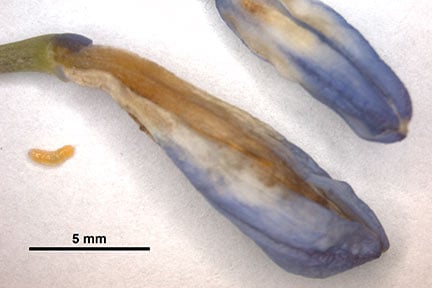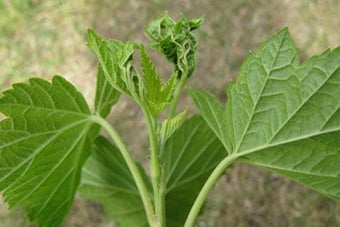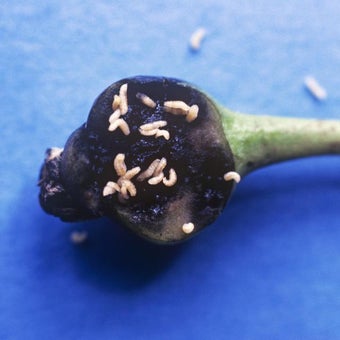
Quick facts
Common name - Agapanthus gall midge
Scientific name - Enigmadiplosis agapanthi
Plants affected - Agapanthus species and cultivars
Main symptoms - Deformed and browning flower buds that fail to open
Caused by - Larvae of a small fly
Timing - June to late September
What is agapanthus gall midge?
Agapanthus gall midge is a tiny fly that lays eggs on the developing flower of Agapanthus. The feeding activities of the larvae inside the buds cause abnormal development and affected buds usually fail to open.
Gall midges are a family of flies, the Cecidomyidae, there are more than 600 species found in Britain. As adults most are small brown or black flies, they do not bite. As the name suggests many species feed as larvae within plant tissues causing galling and distortion. Some are however, predatory on aphids and mites whilst others feed on rust fungi.
Until 2016 the species of midge causing this problem was undescribed (i.e. new to science). Consequently we had very knowledge known about the biology and lifecycle of this insect. The Plant Health team at RHS Garden Wisley carried out research from its discovery in 2014 until 2020 to fill some of these knowlege gaps and inform the advice given below. The results of the main project, completed in collaboration with ADAS and funded by the AHDB can be downloaded from: https://horticulture.ahdb.org.uk/development-of-novel-control-options-for-agapanthus-gall-midge-2
Symptoms
If the foliage of Agapanthus appears healthy but the flowers are abnormal in the ways described below, then agapanthus gall midge is most likely the cause:
- Affected flower are deformed in shape and may have patches of brown discolouration
- Affected buds fail to open and either dry up or rot
- If the infestation occurs as the flower spike is developing, the entire flower head may collapse or fail to develop
- Numerous creamy yellow or orange maggots, up to 3mm long, may be found inside the buds, crawling around in a watery liquid
Management
Currently management strategies attempt to interrupt the insects life cycle:
- Monitor closely for symptoms as soon as flower start to develop
- Re-pot container grown plants, replacing growing media to remove pupating or overwintering larvae
- Consider applying a or pot topper to the area where the larvae are likely to fall to when they leave the flowers to pupate. Specifically Strulch (a straw based mulch) and MelCourt EcoBark (a -based pot-topper were effective at reducing or delaying the emergence of pupating midges in our recent laboratory study, but this needs validating on plants in outdoor conditions
- Remove and destroy affected flower heads
- Destroy badly affected plants
Biology
The tiny gall midge lays eggs on the plant and the larvae develop inside the individual flower , inside the flower head sheath or in the petals of flowers that have gone over. The larvae can then cause the to be deformed and discoloured and often fail to open, as their feeding activities convert the plant material into a gall. The severity of the damage can range from a couple of buds failing to collapse of the entire flower head.
The presence of the gall midge can be confirmed by opening the buds or flower heads and looking for the presence of small maggots 1-3 mm in length which are a creamy yellow colour. The midge larvae leave the flower head to pupate in the soil, which takes around ten days. It is likely that they also overwinter in the soil and pupate the next spring.
The larvae can live in any stage of flower development, including in senesced flowers. Larvae can most commonly be seen inside individual flower buds, but if infestation occurs before the flower head sheath opens then the larvae can live and feed between the developing flowers and cause complete failure of the flower head.
Our research so far has shown that there may be multiple overlapping generations of the midge, as active larvae have been seen between mid-June and early October.
So far no treatments have proven effective at targeting the larvae in the flowers. This is unsurprising as they develop inside the plant tissue and the long active period of the adults makes targeting egg-laying females difficult. The underground pupation and overwintering life stage is likely to be the most useful target for management.





